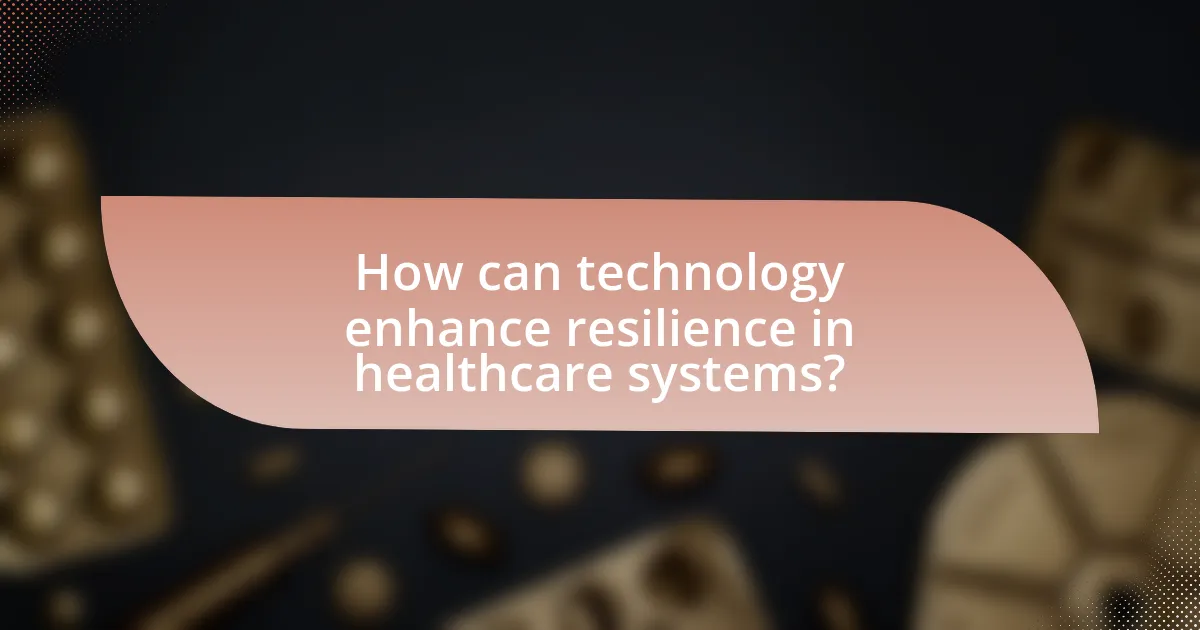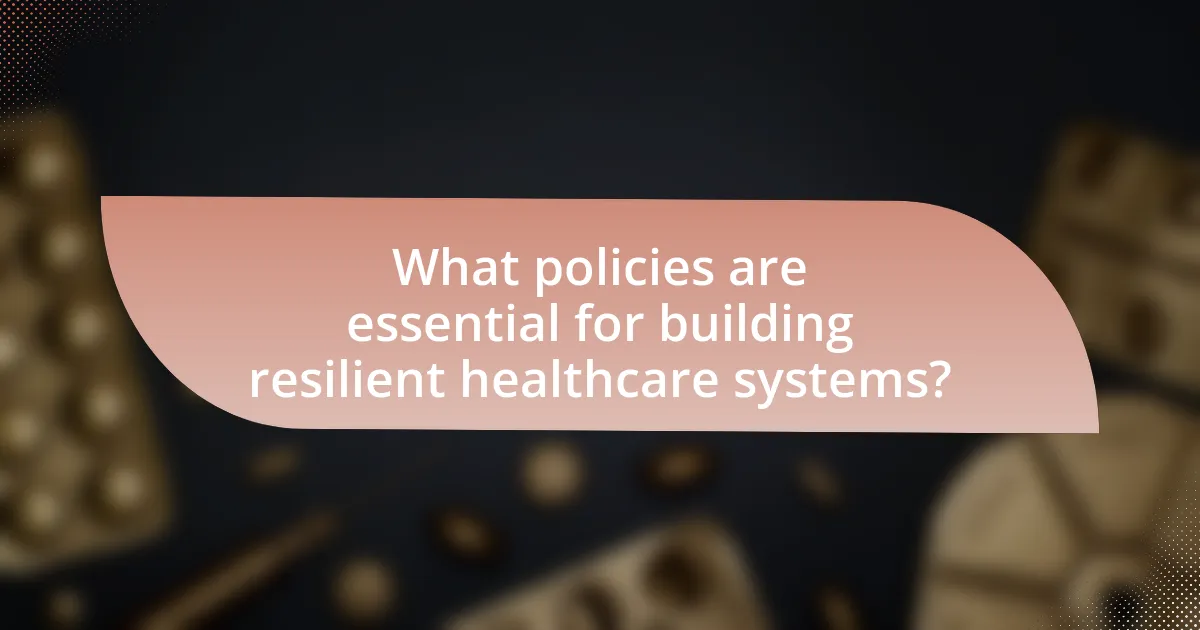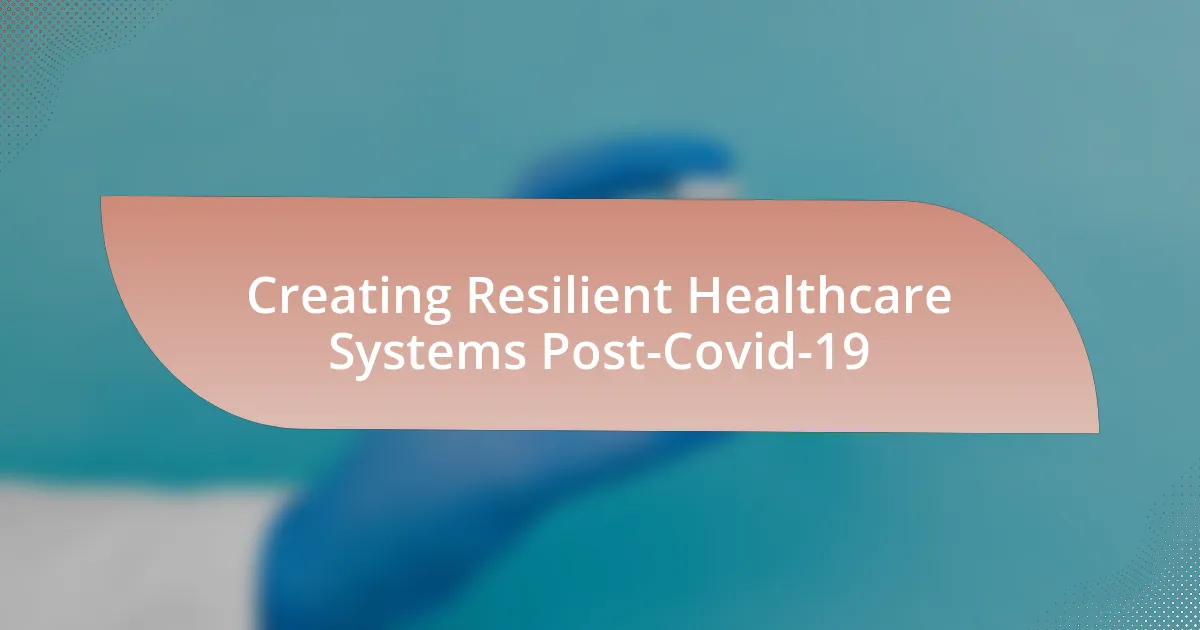The article focuses on creating resilient healthcare systems in the aftermath of the Covid-19 pandemic. It outlines key elements necessary for this transformation, including strengthening public health infrastructure, enhancing workforce capacity, ensuring equitable access to care, and leveraging technology. The discussion highlights vulnerabilities exposed during the pandemic, such as inadequate staffing and supply chain issues, while emphasizing the importance of telehealth and data analytics in improving healthcare responsiveness. Additionally, it addresses essential policies, funding models, and community engagement strategies that can enhance healthcare resilience for future crises.

What are the key elements of creating resilient healthcare systems post-Covid-19?
The key elements of creating resilient healthcare systems post-Covid-19 include strengthening public health infrastructure, enhancing workforce capacity, ensuring equitable access to care, and leveraging technology for better health outcomes. Strengthening public health infrastructure involves investing in surveillance systems and emergency preparedness, which are critical for responding to future health crises. Enhancing workforce capacity requires training and retaining healthcare professionals to meet increased demand, as evidenced by the World Health Organization’s report highlighting the need for 18 million additional health workers by 2030. Ensuring equitable access to care addresses disparities revealed during the pandemic, necessitating policies that promote inclusivity and accessibility. Finally, leveraging technology, such as telehealth and data analytics, can improve service delivery and patient management, as demonstrated by the rapid adoption of telemedicine during Covid-19, which increased by 154% in the U.S. in March 2020 compared to the previous year.
How did the Covid-19 pandemic expose vulnerabilities in healthcare systems?
The Covid-19 pandemic exposed vulnerabilities in healthcare systems by revealing inadequate preparedness, insufficient staffing, and lack of access to essential medical supplies. For instance, many hospitals faced overwhelming patient loads due to a surge in Covid-19 cases, which highlighted staffing shortages and the need for better workforce management. Additionally, the pandemic caused significant disruptions in supply chains, leading to shortages of personal protective equipment (PPE) and ventilators, as reported by the World Health Organization. These factors collectively underscored the necessity for healthcare systems to enhance their resilience and adaptability in the face of future public health crises.
What specific weaknesses were identified in healthcare infrastructure?
Specific weaknesses identified in healthcare infrastructure include inadequate supply chain management, insufficient staffing levels, and lack of interoperability among health information systems. Inadequate supply chain management was highlighted during the COVID-19 pandemic, leading to shortages of essential medical supplies and personal protective equipment, as reported by the World Health Organization. Insufficient staffing levels resulted in overwhelmed healthcare workers, contributing to burnout and decreased quality of care, as noted in studies by the American Medical Association. Additionally, the lack of interoperability among health information systems hindered effective data sharing and coordination of care, as emphasized in research published by the National Academy of Medicine.
How did the pandemic impact healthcare workforce dynamics?
The pandemic significantly altered healthcare workforce dynamics by accelerating staffing shortages and increasing burnout among healthcare professionals. As hospitals faced unprecedented patient volumes and resource constraints, many healthcare workers experienced heightened stress and fatigue, leading to a rise in resignations and early retirements. According to a survey by the American Nurses Association, 20% of nurses reported considering leaving the profession due to pandemic-related stressors. Additionally, the shift towards telehealth expanded the demand for digital skills among healthcare workers, necessitating rapid training and adaptation. This transformation highlighted the need for improved workforce planning and support systems to enhance resilience in the healthcare sector.
What lessons can be learned from the Covid-19 response?
The Covid-19 response highlights the importance of preparedness and adaptability in healthcare systems. Effective responses were characterized by rapid mobilization of resources, clear communication, and collaboration across sectors. For instance, countries that had pandemic preparedness plans in place, such as South Korea, were able to implement widespread testing and contact tracing quickly, resulting in lower transmission rates. Additionally, the pandemic underscored the necessity of investing in healthcare infrastructure and technology, as seen in the accelerated adoption of telehealth services, which improved access to care during lockdowns. These lessons emphasize that resilient healthcare systems must prioritize flexibility, resource allocation, and inter-agency cooperation to effectively manage future public health crises.
What strategies proved effective in managing healthcare during the pandemic?
Telehealth services proved effective in managing healthcare during the pandemic by facilitating remote consultations and reducing the risk of virus transmission. The rapid expansion of telehealth allowed healthcare providers to maintain continuity of care while adhering to social distancing guidelines. According to a report from the U.S. Department of Health and Human Services, telehealth visits increased by 154% in March 2020 compared to the previous year, demonstrating its critical role in healthcare delivery during the crisis. Additionally, the implementation of triage protocols and the establishment of dedicated COVID-19 treatment centers helped streamline patient care and optimize resource allocation, further enhancing the healthcare system’s response to the pandemic.
How can these strategies be adapted for future crises?
Strategies for creating resilient healthcare systems can be adapted for future crises by implementing flexible resource allocation, enhancing telehealth capabilities, and fostering inter-agency collaboration. Flexible resource allocation allows healthcare systems to quickly redirect personnel and supplies to areas of greatest need, as demonstrated during the COVID-19 pandemic when hospitals repurposed staff and equipment to manage surges in patient volume. Enhancing telehealth capabilities ensures that patients can receive care remotely, which proved essential during lockdowns and can be expanded to improve access in future emergencies. Fostering inter-agency collaboration, as seen in successful responses to past health crises, enables a coordinated approach that leverages the strengths of various organizations, ensuring a more effective response to future challenges.

How can technology enhance resilience in healthcare systems?
Technology enhances resilience in healthcare systems by enabling real-time data sharing, improving telehealth services, and facilitating remote patient monitoring. For instance, the integration of electronic health records allows for seamless communication among healthcare providers, which is crucial during emergencies. A study published in the Journal of Medical Internet Research found that telehealth usage surged by 154% during the COVID-19 pandemic, demonstrating its effectiveness in maintaining patient care while minimizing exposure risks. Additionally, remote monitoring technologies, such as wearable devices, empower patients to manage chronic conditions effectively, reducing hospital readmissions and ensuring continuity of care. These technological advancements collectively strengthen healthcare systems’ ability to respond to crises and adapt to changing circumstances.
What role does telemedicine play in strengthening healthcare delivery?
Telemedicine significantly strengthens healthcare delivery by enhancing access to medical services, particularly in underserved areas. It allows patients to consult healthcare providers remotely, reducing barriers such as distance and transportation challenges. A study published in the Journal of Medical Internet Research found that telemedicine increased patient engagement and satisfaction, with 70% of patients reporting improved access to care. Furthermore, during the COVID-19 pandemic, telemedicine facilitated continuity of care, enabling healthcare systems to manage patient loads effectively while minimizing the risk of virus transmission. This adaptability demonstrates telemedicine’s critical role in creating resilient healthcare systems.
How has telemedicine evolved since the onset of Covid-19?
Telemedicine has significantly evolved since the onset of Covid-19, transitioning from a niche service to a mainstream healthcare delivery method. The pandemic accelerated the adoption of telehealth technologies, with a reported increase of over 154% in telehealth visits in March 2020 compared to the previous year, according to the Centers for Disease Control and Prevention. This shift was driven by the need for social distancing and the desire to minimize virus transmission, leading to expanded access to virtual consultations across various medical specialties. Additionally, regulatory changes, such as the temporary relaxation of HIPAA regulations and increased reimbursement for telehealth services, facilitated this rapid growth, allowing healthcare providers to offer remote care more efficiently.
What are the challenges and benefits of implementing telehealth solutions?
Implementing telehealth solutions presents both challenges and benefits. The primary challenge includes technological barriers, such as inadequate internet access and lack of digital literacy among patients, which can hinder effective use. Additionally, regulatory issues and reimbursement policies can complicate the integration of telehealth into existing healthcare systems. On the other hand, the benefits of telehealth solutions include increased access to care, particularly for rural populations, and improved patient engagement through convenience and flexibility. Studies indicate that telehealth can reduce healthcare costs and improve health outcomes, as evidenced by a report from the American Medical Association showing a 50% increase in telehealth visits during the COVID-19 pandemic, highlighting its effectiveness in maintaining continuity of care.
How can data analytics improve healthcare system responsiveness?
Data analytics can significantly improve healthcare system responsiveness by enabling real-time data processing and predictive modeling. By analyzing patient data, healthcare providers can identify trends, allocate resources efficiently, and anticipate patient needs, leading to quicker response times during emergencies. For instance, a study published in the Journal of Medical Internet Research found that predictive analytics reduced hospital readmission rates by 20% by allowing for timely interventions. This demonstrates that leveraging data analytics not only enhances operational efficiency but also improves patient outcomes, making healthcare systems more resilient in the face of challenges like those posed by the Covid-19 pandemic.
What types of data are most valuable for healthcare decision-making?
Clinical data, including patient health records, treatment outcomes, and diagnostic information, are the most valuable types of data for healthcare decision-making. This data enables healthcare providers to assess the effectiveness of treatments, identify trends in patient health, and make informed decisions regarding patient care. Additionally, population health data, which encompasses demographic information and disease prevalence, supports public health initiatives and resource allocation. According to a study published in the Journal of the American Medical Association, leveraging clinical and population health data can significantly improve patient outcomes and optimize healthcare delivery systems.
How can predictive analytics help in managing future health crises?
Predictive analytics can significantly enhance the management of future health crises by enabling early detection and response strategies. By analyzing historical health data, trends, and patterns, predictive models can forecast potential outbreaks, identify at-risk populations, and optimize resource allocation. For instance, during the COVID-19 pandemic, predictive analytics was utilized to model infection rates and hospitalizations, allowing healthcare systems to prepare and allocate resources effectively. Studies have shown that organizations employing predictive analytics can reduce response times by up to 30%, thereby improving overall health outcomes and minimizing the impact of health crises.

What policies are essential for building resilient healthcare systems?
Essential policies for building resilient healthcare systems include strengthening public health infrastructure, ensuring universal health coverage, and enhancing workforce capacity. Strengthening public health infrastructure involves investing in surveillance systems, emergency preparedness, and data management to respond effectively to health crises. Ensuring universal health coverage guarantees access to essential health services for all individuals, which is crucial for maintaining population health during emergencies. Enhancing workforce capacity focuses on training and retaining healthcare professionals, which is vital for sustaining healthcare delivery during surges in demand, as evidenced by the increased strain on healthcare systems during the COVID-19 pandemic. These policies collectively contribute to a robust healthcare system capable of withstanding future challenges.
How can governments support healthcare system resilience?
Governments can support healthcare system resilience by investing in infrastructure, workforce training, and technology. For instance, increased funding for healthcare facilities enhances their capacity to respond to crises, as evidenced by the World Health Organization’s recommendation for countries to allocate at least 5% of their GDP to health systems. Additionally, governments can implement policies that promote workforce development, ensuring that healthcare professionals are adequately trained and available during emergencies. The COVID-19 pandemic highlighted the importance of telehealth technologies, and governments can facilitate their integration into healthcare systems, improving access and continuity of care. These actions collectively strengthen the healthcare system’s ability to withstand and recover from future challenges.
What funding models are most effective for healthcare sustainability?
Value-based care models are among the most effective funding models for healthcare sustainability. These models prioritize patient outcomes over the volume of services provided, incentivizing healthcare providers to deliver high-quality care while managing costs. According to a study published in the Journal of the American Medical Association, value-based care has been associated with improved patient satisfaction and reduced healthcare expenditures, demonstrating its effectiveness in promoting sustainable healthcare systems. Additionally, bundled payment models, which provide a single payment for all services related to a treatment or condition, have shown success in reducing costs and improving care coordination, further supporting the sustainability of healthcare systems.
How can public-private partnerships enhance healthcare resilience?
Public-private partnerships can enhance healthcare resilience by facilitating resource sharing, improving innovation, and increasing efficiency in service delivery. These collaborations allow public entities to leverage private sector expertise and funding, which can lead to faster development and deployment of healthcare solutions, especially during crises like the COVID-19 pandemic. For instance, during the pandemic, partnerships between governments and private companies enabled rapid vaccine development and distribution, demonstrating how such collaborations can effectively respond to urgent healthcare needs. Additionally, these partnerships can improve infrastructure and technology integration, ensuring that healthcare systems are better equipped to handle future challenges.
What role does community engagement play in healthcare resilience?
Community engagement is crucial for enhancing healthcare resilience by fostering trust, improving health literacy, and facilitating resource mobilization. Engaged communities are more likely to participate in health initiatives, leading to better health outcomes and quicker recovery during crises. For instance, during the COVID-19 pandemic, communities that actively engaged in public health messaging and vaccination campaigns saw higher vaccination rates and adherence to health guidelines, demonstrating the effectiveness of community involvement in mitigating health crises. This engagement not only strengthens the healthcare system’s response but also builds long-term relationships that enhance overall community health resilience.
How can communities be empowered to contribute to healthcare solutions?
Communities can be empowered to contribute to healthcare solutions by fostering local engagement, education, and resource allocation. Local engagement encourages community members to participate in health initiatives, such as vaccination drives and health education programs, which have been shown to increase public health outcomes. Education equips individuals with knowledge about health issues, enabling them to make informed decisions and advocate for their needs. Resource allocation, including funding for community health projects, enhances the capacity of local organizations to address specific health challenges effectively. For instance, the World Health Organization emphasizes the importance of community involvement in health systems, stating that empowered communities lead to improved health outcomes and resilience, particularly in the aftermath of crises like the Covid-19 pandemic.
What are effective strategies for increasing public health awareness?
Effective strategies for increasing public health awareness include utilizing social media campaigns, community engagement initiatives, and educational programs. Social media campaigns can reach a broad audience quickly; for instance, the CDC’s “Tips From Former Smokers” campaign effectively raised awareness about smoking cessation, resulting in over 1.6 million calls to quitlines. Community engagement initiatives, such as health fairs and workshops, foster direct interaction and provide tailored information, enhancing local understanding of health issues. Educational programs in schools and workplaces can also promote health literacy, as evidenced by studies showing that health education significantly improves knowledge and behavior regarding health practices.
What best practices can be adopted for future healthcare resilience?
To enhance future healthcare resilience, adopting a multi-faceted approach that includes strengthening supply chains, investing in technology, and fostering community partnerships is essential. Strengthening supply chains ensures that essential medical supplies and equipment are readily available during crises, as evidenced by the shortages experienced during the COVID-19 pandemic. Investing in technology, such as telehealth services, improves access to care and allows for continuity of services during emergencies. Additionally, fostering community partnerships enhances public health responses by leveraging local resources and knowledge, which has been shown to improve health outcomes in various studies. These best practices collectively contribute to a more robust and adaptable healthcare system capable of withstanding future challenges.


